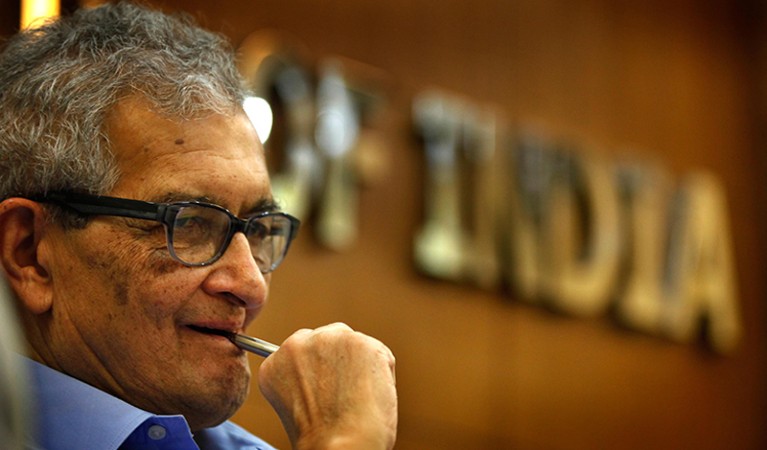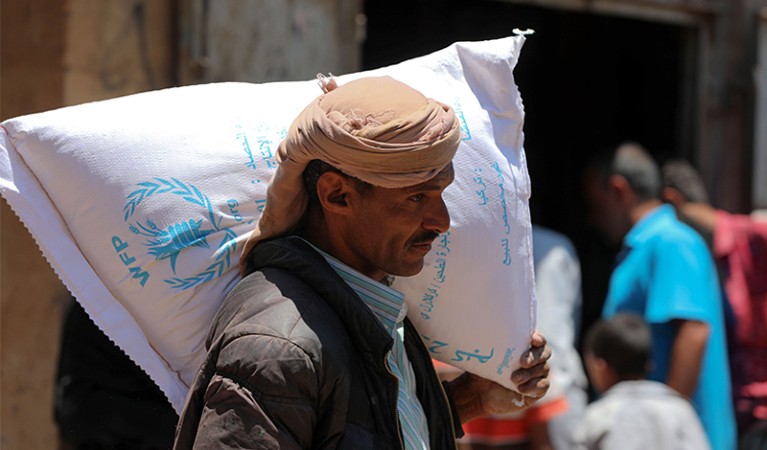
Economist Amartya Sen described in his 1981 book Poverty and Famines how famines are linked to the policies of governments.Credit: Raj K Raj/Hindustan Times/Getty
Around 200 million people are experiencing acute food insecurity. They include some in Afghanistan, Burkina Faso, Ethiopia, Mali, Sudan and Syria, countries that have something else in common: each is experiencing a deadly conflict. These two situations — hunger and conflict — are connected.
In a report presented to the United Nations in March, the organization’s special rapporteur on the right to food, Michael Fakhri, said that violence and conflict are in fact the primary causes of hunger worldwide. They are also pivotal reasons that the world is not on track to end hunger and malnutrition by 2030, a promise made by world leaders at a UN summit in 2015, as part of the Sustainable Development Goals (SDGs).
This is alarming for a number of reasons. For one thing, it suggests that, unless something is done, we are abandoning hundreds of millions of people to severe hunger. Furthermore, crucial efforts to study and implement policies to end hunger are hampered when violence breaks out.
In September, heads of government will meet in New York City to work out what can be done. Although the meeting takes a place at a time of great tension between world powers, attendees must accept that the SDG to end hunger will not be met unless violence is reduced — or, at the very least, unless parties to conflict stop weaponizing food.
Fakhri’s report draws on decades of studies, as well as newer data from bodies including the UN’s World Food Programme and the Food and Agriculture Organization of the UN. The report describes the relationship between violence in various forms, including sexual and gender-based violence, and food insecurity. Conflicts endanger food security when, for example, crops are destroyed or food supplies are disrupted — things that have happened, and continue to happen, in wars from Mali to Myanmar. Coercive measures, such as international economic sanctions against warring countries, also contribute to hunger. The evidence, according to the report, is that ‘targeted’ sanctions disrupt food systems, too.

The international community needs to stop weaponizing food in conflicts, as has happened in Yemen (pictured).Credit: Ahmad Al-Basha/AFP/Getty
The UN special rapporteur’s report also brings home how global economic events are exacerbating hunger and food insecurity. Food prices have rocketed in most places, especially in low- and middle-income countries (LMICs). In the rich countries that are members of the Organisation for Economic Co-operation and Development, food-price inflation dropped to around 12% on average in April, but it remains much higher in a number of LMICs — 81% in Lebanon, 27% in Egypt and 30.5% in Zimbabwe, according to World Bank data published last month. That is down to factors such as the COVID‑19 pandemic and Russia’s invasion of Ukraine. The war affected the global supply of staple crops — before the invasion, Russia and Ukraine together grew one-third of the world’s wheat. The global spike in energy prices is also affecting the ability of the poorest families to use gas and other fuels for cooking.
But researchers are reporting that food inflation is also partly caused by producers, especially large firms, putting up prices to increase their profits. Sellers can do this if they know that a buyer has no choice but to pay more to obtain things they cannot do without, such as food and fuel — a phenomenon that researchers call sellers’ inflation. That might be one reason that inflation remains stubbornly high, especially when it comes to food, and that interventions such as raising interest rates have failed to reduce it.
This is the conclusion of two working papers led by Isabella Weber, an economist at the University of Massachusetts Amherst. In a modelling study published last November, Weber and her co-authors found that the prices of food and energy are the two largest drivers of inflation (I. M. Weber et al. Economics Department Working Paper Series 340; 2022). In a subsequent study, in February, the authors sampled a group of US companies in these sectors and discovered that in 2022, profits were responsible for as much inflation as wages, if not more (I. M. Weber and E. Wasner Economics Department Working Paper Series 343; 2023).
Weber’s work is sparking change among some governments and getting attention from financial institutions. The International Monetary Fund found last month that corporate profits accounted for nearly half of inflation in the euro area last year (N.-J. H. Hansen et al. IMF Working Paper No. 2023/131; 2023).
Weber is among those advocating that governments put a ceiling on some of the prices that producers can charge. However, many academic economists — and the governments they advise — disagree, saying that such price controls distort markets. The poorest people are caught in the middle of this argument, experiencing harm as a result of both high prices and policy delays.
It’s important for researchers to continue to uncover evidence about what is exacerbating hunger and how it can be eliminated. More could, for example, study how conflicts affect hunger on a more granular level. They could analyse the components of inflation not only in Europe and the United States, but in LMICs, too. Economist Amartya Sen demonstrated in his 1981 book Poverty and Famines that hunger and famine are not necessarily the result of food shortages, but created by the actions and choices of people. Leaders could make good on their SDG pledge that hunger and malnutrition must end, or they could continue to target food in conflicts. Both are choices, as Fakhri says, and not predetermined outcomes.

 The war in Ukraine is exposing gaps in the world’s food-systems research
The war in Ukraine is exposing gaps in the world’s food-systems research
 Imagine a world without hunger, then make it happen with systems thinking
Imagine a world without hunger, then make it happen with systems thinking
 Ending Hunger: Science must stop neglecting smallholder farmers
Ending Hunger: Science must stop neglecting smallholder farmers
 Does the fight against hunger need its own IPCC?
Does the fight against hunger need its own IPCC?
 Reset Sustainable Development Goals for a pandemic world
Reset Sustainable Development Goals for a pandemic world







